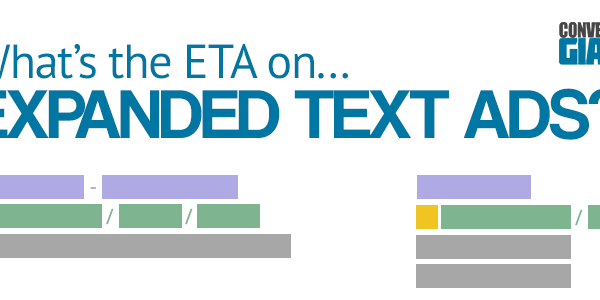Expanded text ads (ETAs) rolled out to all AdWords accounts in July of 2016. ETAs allow advertisers to include more copy in their ads to further convey the product or service they’re advertising and ultimately improve the search experience. If you’ve been advertising for awhile, you’re probably more familiar with standard text ads (STAs).
What’s the Difference Between Standard Text Ads and Expanded Text Ads?
Beyond the obvious fact that ETAs offer advertisers more space, what other features do they offer? ETAs include:
- Two headlines (instead of one)
- 30-characters per headline (instead of 25)
- 80-character description field (instead of two 35 character fields)
- The display URL is automatically generated based on the final URL domain with the option to combine it with two new optional path fields
- No differentiation between mobile and desktop

Source: https://support.google.com/adwords/answer/7048854?hl=en
Why Did Google Introduce ETAs?
In February of 2016, Google removed the ads that used to appear on the right-hand side of search results. This was an effort to align with the increase in mobile browsing, which is exactly why Google introduced ETAs as well.
When people are searching on-the-go on their Smartphone, they want to be sure that they’re clicking through to a website that will deliver what they’re expecting. They don’t have time to go back and browse the other results, or worse, revise their search. The ETAs allow advertisers to include more detail, letting searchers know exactly what they’re getting by clicking through.
What About Your Standard Text Ads (STAs)?
As of January 31, 2017, you will no longer be able to create or edit Standard Text Ads (STAs), also known as legacy ads. But don’t panic! Your existing STAs can still run, but you’ll no longer be able to make changes after the deadline. This presents some interesting challenges for advertisers…Read on.
Are ETAs All That They’re Cracked Up to Be?
Marketers, business owners, and SEOs have expressed mixed feelings about ETAs and whether or not they’re more effective than the legacy ads. From an advertising standpoint, here’s what you need to consider now that you’ll no longer be able to create new STAs:
- Time to change your ad copy. You or your ad agency worked hard to craft the perfect copy to fit the parameters of the STA limits. Well, now it’s time to revise your copy.
- Less prominent. When ETAs originally rolled out, they stood out over STAs because they were larger. As ads transition to the larger ads, people may become accustomed to seeing only ETAs and keep scrolling.
- Your quality score might suffer. When making changes to your ad, you might be tampering with your relevancy which can negatively impact your quality score.
- Mobile vs. Desktop. With STAs, you could create separate ads for mobile devices. ETAs don’t differentiate between devices so ad copy will need to be able to effectively speak to both groups.
- Organic results will now appear even further down. The larger ads push organic results down, forcing marketers to be even more cautious of how effective their SEO strategy is.
How to Maintain & Increase Your Click Through Rate (CTR)
Google shared some tips for making the most of your ETAs but here’s what we recommend:
- Create brand new ads with new copy NOW. With the deadline right around the corner, now is the time to start transitioning your ads before it’s too late to make changes to them.
- A/B test. When you create your new ads, avoid changing too many elements at once. Test one at a time to determine what’s driving more click throughs.
- Include keywords in your display URL path. This will help ensure your ad is as relevant as possible and boost your quality score.
- Update your ad extensions. Now that you’ll be including more copy in your ads, you might be repeating some of the information in your ad extensions. Revisit your ads to update your ad extensions ASAP.
- Evaluate what’s working. Using all the allowable characters might not necessarily drive the highest CTR. Try and stay true to what worked in your legacy STAs and repurpose the same strategy in your new ads.
- Revisit your entire SEO strategy. In addition to amending your PPC strategy, take a hard look at your SEO strategy to ensure your site is optimized for search. With ETAs pushing organic results further down, your business will need all the help it can get to rank in the top positions.
If you need some help optimizing your ads to fit the upgraded ETAs, talk to an expert with extensive PPC experience.







